|
|
|
Sort Order |
|
|
|
Items / Page
|
|
|
|
|
|
|
| Srl | Item |
| 1 |
ID:
191120
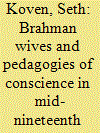

|
|
|
|
|
| Summary/Abstract |
This article argues that from circa 1845–1857, British colonial officials and administrators, abetted by Protestant missionaries and some so-called ‘native Christians’, attempted to replace Brahmanical regulation of everyday life with what I am calling ‘governance by conscience’ in British India. It uses the 1851 legal ruling in Narayen Ramchundur versus Luxmeebae, hailed by some for bringing ‘liberty of conscience’ and condemned by others as a wanton violation of Hindu personal law, to elucidate the connections between the Caste Disabilities Removal Act of 1850 (Act XXI) and education. My analysis highlights the centrality of Brahman wives and gender to debates about conscience, caste, property, and Christian conversion. During the violent summer of 1857, some condemned the Act and its use in deciding the case of Narayen Ramchundur versus Luxmeebae as provocation for the traumatic disorders then threatening to dismantle Britain's Indian empire.
|
|
|
|
|
|
|
|
|
|
|
|
|
|
|
|
| 2 |
ID:
191118
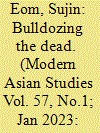

|
|
|
|
|
| Summary/Abstract |
This article looks at lawsuits surrounding two Chinese cemeteries in the mid-twentieth century South Korean cities of Incheon and Seoul as crucial sites to examine the post-colonial legal construction of national citizenry based on property rights. While different legal rationales were employed in each case, the two Chinese cemeteries were relocated to the periphery of each city as a consequence of the litigation. In Incheon, it was argued that the cemetery was owned by Chinese nationals whose land rights were ambiguous and hence open to question, both during the colonial and post-colonial period. On the other hand, in Seoul, rights to the cemetery were at stake due to its association with Japanese nationals, whose holdings were regarded as ‘enemy properties’ in the post-colonial years. Not only were the lawsuits symbolic events that foreshadowed the displacement of Chinese residents from what was considered to be Korea's national land, they also revealed an operative ambiguity in the post-colonial legal system, readily exploited as a tool for discrimination. Drawing upon an analysis of these cases, I argue that the Chinese cemeteries served as a reminder that uncertainty and ambiguity were on tap in the legal workings of post-colonial society, manifested in blunt efforts to define its legitimate members and dictate who is entitled to be buried within a nation's borders.
|
|
|
|
|
|
|
|
|
|
|
|
|
|
|
|
| 3 |
ID:
191122
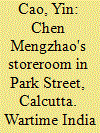

|
|
|
|
|
| Summary/Abstract |
This article is about the experiences of three Chinese men who were involved in smuggling between India and China during the Second World War. Chen Mengzhao's rise as a leading figure in India-China smuggling in Calcutta uncovers the hidden links between the black markets in India and China during the Second World War. Gao Wenjie disguised himself as a Chinese army officer and utilized this fake identity to facilitate his smuggling business. Wang Li-an was sent to Calcutta to undertake smuggling for a Chinese government department. In telling these stories, this article argues that most smuggling in modern India and China was undertaken in transnational contexts that resulted in transnational effects. Ironically, the Nationalist government's state-building project to contain India-China smuggling ended by facilitating it. This project was further perceived by the British authorities as a Chinese conspiracy against India's sovereignty. The misunderstanding between the Chinese and British authorities led to the end of Chinese immigration to India in 1945. Overall, this article provides a new perspective to make sense of the tensions between the Chinese, Indian, and British governments during the Second World War.
|
|
|
|
|
|
|
|
|
|
|
|
|
|
|
|
| 4 |
ID:
191116


|
|
|
|
|
| Summary/Abstract |
This article addresses the Taipei National Revolutionary Martyrs’ Shrine (Guomin geming zhonglie ci) as a site of contention over national sovereignty and belonging. The shrine originated in Sun Yat-sen's aspiration to commemorate the anti-imperial martyrs of the 1911 Republic and in the Nationalist government's attempt to marshal political allegiance in the 1920s–1940s. Upon fleeing from the mainland to Taiwan after losing to the Communist forces in 1949, the Nationalist leadership renovated the Japanese-built National Protection Shrine in Taipei, transforming it into the National Revolutionary Martyrs’ Shrine to house the displaced spirits of the national dead. Throughout the Cold War era, the spring and autumn sacrifices performed by heads of state and visits to the shrine by foreign dignities served to affirm the sovereignty of the Republic of China vis-à-vis the People's Republic of China. Even though the end of martial law in 1987 opened a new era marked by the Nationalist Party's loss of political hegemony, the shrine continued to adhere to the Nationalist Party's ideology and version of history. Far from embodying a place of remembrance and mourning for war victims, the palace-style compound is a site of contested sovereignty exaggerated by China's extraordinary growth and Taiwan's transforming identity. The enshrined dead have found a new role as both an assertion of the island's autonomy and a reflection of its dynamism. The departed, albeit silent, hold power in the malleability of their memories, and each permutation of how the past is remembered hosts its own tension.
|
|
|
|
|
|
|
|
|
|
|
|
|
|
|
|
| 5 |
ID:
191119


|
|
|
|
|
| Summary/Abstract |
In the late 1950s, work began on the Kaptai hydroelectric dam, a massive project in the verdant Chittagong Hill Tracts (CHT), an area bordering northeast India, east Pakistan (today Bangladesh), and Burma (now Myanmar), largely populated by indigenous hill communities. At the time, the CHT was situated in newly created East Pakistan, and Kaptai had become a focal site for the development of hydroelectric power. In the process, Pakistan relied upon international networks, including global aid organizations and American multinational construction firms, to fulfil its development dreams; in return the United States found a useful ally to contain Soviet influence and the growth of communism in Asia. In the high stakes exchange of economic aid for political alliance-making, East Pakistani administrators, US State Department officials, and American corporations became inherently entwined in a shared vision of development, to the detriment of local ecologies and the indigenous peoples who lived within them. This article will explore how both the public and private sectors used the language of primitivity, wildness, and atavism to marginalize minority ‘tribal’ populations in the devastating name of development and modernity.
|
|
|
|
|
|
|
|
|
|
|
|
|
|
|
|
| 6 |
ID:
191117


|
|
|
|
|
| Summary/Abstract |
In recent years, a new trend of performing a ‘good death’ has swept Japanese society. Popular, especially among the elderly, shūkatsu (終活) refers to the phenomenon of preparing for one's own demise through various practices, in particular, the writing of an ‘ending note (エンディングノート)’. A will designates the beneficiaries of one's estate or property after one's passing, whereas an ending note not only includes financial and legal matters, it goes far beyond that. It contains provisions for the deceased-to-be's end-of-life treatments, such as hospice care, as well as explicit instructions for seemingly mundane details such as the guest list, flower arrangements, and casket for one's funeral. This trend of engaging in shūkatsu can be viewed as a part of the biopolitics of a super-ageing Japanese society in which the elderly are now expected to manage all aspects of their own lives—including the disposal of their bodily remains when they pass away. Yet, as this anthropologically informed analysis discloses, such biopolitics also gives rise to a new set of ethical dilemmas for the elderly and their families, constituting a new form of politics of life and death. Indeed, rejecting the neoliberal injunction to efficiently separate death from life, many elderly try to recover—and resituate—death within the social and ethical realm of the living.
|
|
|
|
|
|
|
|
|
|
|
|
|
|
|
|
| 7 |
ID:
191124


|
|
|
|
|
| Summary/Abstract |
This article focuses on Chosŏn's informal diplomacy with the Qing dynasty that guided Chosŏn Korea's diplomatic engagement with Japan in the 1870s. The Chosŏn–Qing literary correspondence in Kang Wi's (姜瑋, 1820–1884) brush talk records has been viewed as historical evidence of Chosŏn's intelligence-gathering activities which formed the basis of a new diplomatic enterprise for dealing with modern imperial powers. What has received less attention, however, is the implementation and implications of the informal diplomacy reflected in Kang's diplomatic activities and his discursive practice. Based on a personal and unofficial account by an intellectual on the margins of the established social and international order, this study revisits the political and intelligence-gathering processes that led up to the 1876 peace agreement, which was the culmination of the Qing and Chosŏn dynasties’ concerted efforts as they transitioned to a changing world order in East Asia. In addition, this article further illuminates Kang's agency, despite his secondary social status, in Chosŏn's changing attitude towards Westerners and Westernized Japan. I argue that as both interviewer and transcriber, and from his position on the periphery of the Confucian ruling elites in the late Chosŏn period, Kang provided a new framework through which to formulate policies by reconfiguring his brush talk records to implement his own agenda as a member of the chungin (middle people) literary elite.
|
|
|
|
|
|
|
|
|
|
|
|
|
|
|
|
| 8 |
ID:
191123
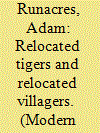

|
|
|
|
|
| Summary/Abstract |
This article will examine state intervention in the lives of tigers and people living in and around Panna Tiger Reserve in Madhya Pradesh, Central India. It explores how, over a decade after a reintroduction project rebuilt the tiger population from extinction and the central government launched a new compensation scheme to relocate villagers away from the national park, relocated tigers and not-yet relocated villagers resist and challenge conservation interventions to eradicate human life in Panna Tiger Reserve and (re)construct it as a wild tiger landscape. It will show how discourses of conservation and development that motivate state intervention seek to depoliticize and obfuscate programmes of control over human and tiger lives through their separation and purported ‘care’, contiguous with colonial policies and discursive practices that have intertwined the fate of wild animals and forest-dependent villagers in this part of India. In their feral subversions against these interventions, relocated tigers and not-yet relocated villagers expose the problematic contradictions and tensions that plague animal management, wildlife conservation, and rural development in India today. Based on 15 months of ethnographic fieldwork, the article draws on case studies and accounts from communities living around Panna Tiger Reserve to present alternatives to colonial and post-colonial discursive legitimizations of state intervention and control, revealing alternate understandings of the entanglement of humans and animals and the categories of ‘wild’ and ‘tame’.
|
|
|
|
|
|
|
|
|
|
|
|
|
|
|
|
| 9 |
ID:
191121
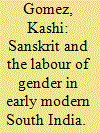

|
|
|
|
|
| Summary/Abstract |
In the early eighteenth century, a husband and co-wife trio undertook a household project in Maratha-ruled Tanjavur. These migrants from the Western Deccan jointly authored a set of Sanskrit commentaries invested in the idea of ‘Maharashtrianness’. The unusual authoring of a Sanskrit commentary by these women alongside their husband exemplifies broader changes that were taking place in Sanskrit intellectual circles in early modern South India. Tracing new formulations of regional identity, changing ideologies of gender, and shifts in the very labour of Sanskrit intellectual production, I demonstrate how new avenues of access to Sanskrit emerged for women in early modern South India. These new avenues of access were facilitated by the growing importance of the household as a site of cultural production and the rise of new regional courts in the Karnatak and Coromandel Coast regions.
|
|
|
|
|
|
|
|
|
|
|
|
|
|
|
|
| 10 |
ID:
191125
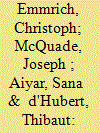

|
|
|
|
|
| Summary/Abstract |
Burma, or Myanmar as it was renamed in 1989, is largely ignored within the discipline of South Asian Studies, despite its cultural, religious, economic, and strategic significance for the wider worlds of Asia. Burma is often studied either in isolation or alongside Southeast Asian countries such as Thailand, Vietnam, and Malaysia, despite its equally important historical and cultural connections to communities, states, and networks across what is now India, Bangladesh, Sri Lanka, or Nepal. In this Roundtable, four scholars of South Asia discuss Burma's erasure within the discipline, the origins and limitations of traditional area studies frameworks, and the possibilities afforded by Burma's inclusion within a more expansive conception of South Asia.
|
|
|
|
|
|
|
|
|
|
|
|
|
|
|
|
|
|
|
|
|